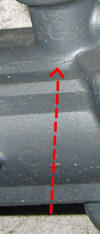
Carburettors.
Standard equipment for a VA's is 2 Skinner Union (SU) type H3. Easily recognised by the castingnumber 3251 in the mainbody.
Most parts apart from the mainbody are ready available from most carburettor parts suppliers.
Typical modern VA carburettor parts numbers as supplied by Burlen:
| Part name | Part number |
| Standard needle | AUD 1105 CO |
| Weak needle | AUD 1105 CP |
| Rich needle | AUD 1105 BK |
| Jet | AUC 8182 |
| Float needle valve | WZX 1101 |
| Float | WZX 1303 |
| Throttle spindle | WZX 988 |
| Throttle disc | AUC 2300 |
| Gasket pack | AUA 25 |
| Fuelpump kit | EPK 700 |
| Feulpump new | AUA 25 |
Biggest problem with VA carburettors is the weakness of the main body made of some kind of Mazac. At the bottem of the mainbody, in the area where the floatchamber is attached develops a crack which can not easily be repaired.
Point of attention for regular maintenance is the hollow bolt with which the floatchamber is attached to the mainbody. This bolt tends to work loose and creates a fuel leak. On the other hand will overtightening of this bolt lead to an early fracture of the mainbody. Good condition sealing rings and a little LockTite on the thread will help.
Another point for improvement is the matching of the carburettor outlets to the carburettor manifold. In most cases the inlet ports of the manifold are much smaller then the carburettors. As there is sufficient material in the manifold they can easily be opened up to improve the gasflow and efficiŽncy.
Running Rich.
Sometimes when you have overhauled your carburettors, new needles, jets, spindles etc it can stil happen that one of the carburettors does not well respond to tuning.
In that case it is worth checking the float levels again, but this time in a different way. Switch off the engine after it has been running for some time. Take off the covers of both float chambers and take out the floats. Now measure the exact distance in between the top of the fuel level and the rim of the float chamber. Quite likely there is a difference in between the two levels !
This can be caused by two different matters. One is that your floats may be different in weight. Just put them together in a bowl of water and compare. If the weights of the floats are equel then they both have the same portion above the water level. If one is floating lower then you have found the culprit !!
If both floats are equel then it may be that although you thought that you have adjusted the float levers according the book; one is slightly different adjusted. So if both floats are equel but the fuel levels different adjust the higher level one to closing the float needle earlier.
In the above picture are two genuine unmolested floats at the front and two "overhauled" ones at the back. The back ones (supplied by an expensive MG parts company) are heavier and unstable. Although the back ones should be a straight fit gave much trouble and a not understood far too rich mixture.